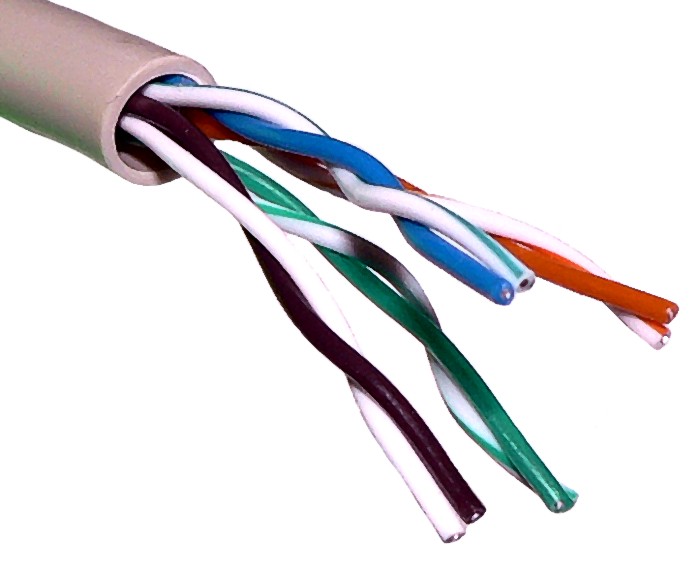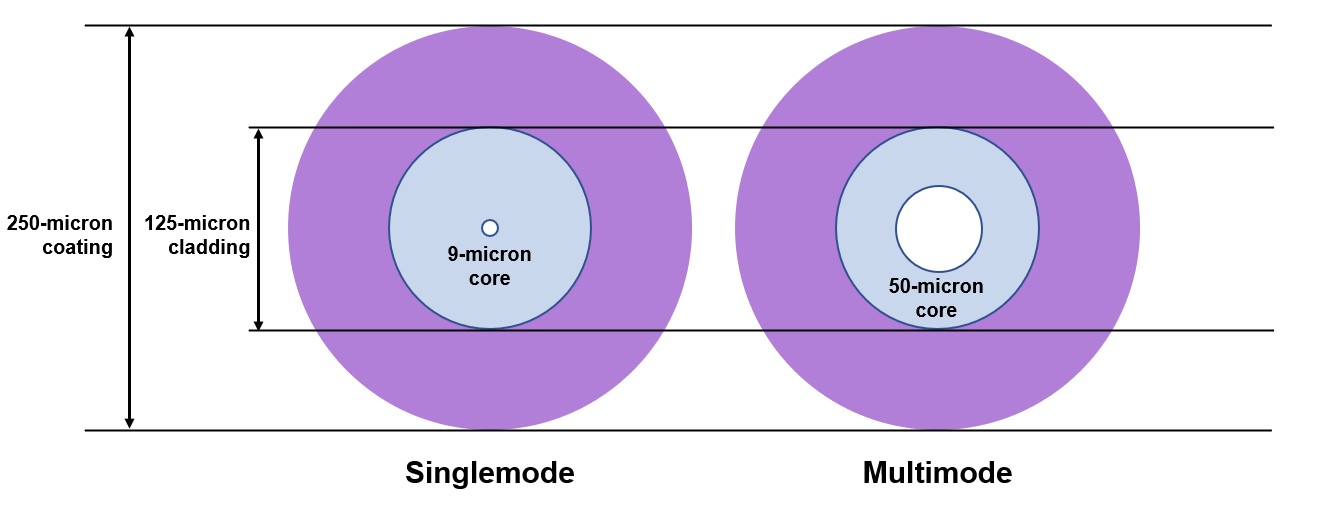Copper Cables vs. Fiber Optic Cables
- May 8th 2024

Local area networks (LANs) and data centers have long been comprised of both copper and fiber cables to establish backbone links between active equipment and horizontal links to connect a wide range of end devices. Knowing the key differences between the two and understanding their capabilities are vital to choosing which is right for your specific application.
Copper Cables

Copper cables are comprised of four twisted pairs of copper conductors that are typically 22 to 24 AWG with thermoplastic insulation and an overall outer jacket. These conductors can be solid or stranded. Solid conductors are single, larger-gauge wires offering better durability and superior attenuation and resistance. Stranded conductors consist of multiple thin wires twisted together, making them more flexible for frequent bending. However, stranded conductors exhibit more attenuation, higher resistance, and are less durable than solid conductors, which is why they are restricted to patch cords and lengths of 10 meters or less via industry standards.
Copper cables transmit Ethernet data as electrical pulses, which also enables them to simultaneously transmit low levels of DC power, such as power over Ethernet (PoE) that delivers up to 90 Watts (W) of power. They come in unshielded and a variety of shielded constructions, with shielding typically required in environments where high-frequency noise can impact performance. They also come in various ratings such as plenum, riser, and outside plant (OSP). Plenum-rated cables are mandatory in air-handling spaces like dropped ceilings or raised floors, while riser-rated cables are suitable for pathways that extend vertically through a building. OSP copper cables are deployed in outdoor environments. However, copper cables can also be rated as indoor/outdoor, meaning that they offer the protection of an OSP cable but also carry a plenum or riser rating to transition from outdoor to indoor locations.
Copper cables are defined as categories, which have evolved over the past 30 years to deliver greater bandwidth. One of the biggest factors impacting speed is the operating frequency—the higher the frequency the faster the transmission speed as shown in the table below.
| Category | Year Ratified | Frequency | Transmission Speed |
| Category 3 | 1991 | 16 MHz | 10 Mb/s |
| Category 4 | 1992 | 20 MHz | 16 Mb/s |
| Category 5 | 1995 | 100 MHz | 100 Mb/s |
| Category 5e | 2001 | 100 MHz | 1000 Mb/s |
| Category 6 | 2002 | 250 MHz | 1000 Mb/s |
| Category 6A | 2009 | 500 MHz | 10 Gb/s |
| Category 7 | 2010 | 600 MHz | 10 Gb/s |
| Category 7A | 2013 | 1200 MHz | 10 Gb/s |
| Category 8 | 2016 | 2000 MHz | 40 Gb/s |
Where are Copper Cables Used?
Copper cables run from telecommunications rooms throughout buildings in a horizontal fashion to a wide range of end devices like Wi-Fi access points, digital displays, security cameras, phones, and laptops while providing superior PoE support. Category 6A cabling is the industry standards-recommended copper cabling for all new horizontal premises LAN deployments due to its ability to support up to 10 Gb/s, delivering maximum future-proofing capabilities. Category 7 and Category 7A are not recognized in North America but remains a popular choice for supporting 10 Gb/s in some parts of Europe. Category 8 was originally designed to support 25 and 40 Gb/s in 30-meter data center switch-to-server links, but it never took off due to the higher power consumption of copper-based switches and servers and advancements in optical transceiver technology. Copper can, however, support lower-speed 10 Gb/s switch-to-server links and is often used for KVM and out-of-band management in data centers.
The Pros of Copper Cabling
Copper cabling offers the following noteworthy benefits that have made it the go-to choice for horizontal LAN infrastructure:
- Can transmit PoE, eliminating the need for separate AC power circuits and conduit for devices and installation by certified electricians
- Uses the familiar RJ45 interface for termination, allowing each new category of cable to be backwards compatible with all previous categories
- Active equipment used with copper cabling systems is more affordable
The Cons of Copper Cabling
Copper cabling also has some disadvantages to consider:
- Limited to 10 Gb/s bandwidth and distanced of 100 meters
- Impacted by electromagnetic interference and less secure
- Not as durable with an overall lower pulling tension and larger diameter and weight compared to fiber cable, occupying more pathway space and making installation more difficult
- Typically considered less sustainable due to cooper being a limited resource that is expensive to mine and produces harmful byproducts during extraction from the earth
- Copper switches consume more energy per port than fiber switches
Fiber Optic Cables

Fiber optic cables are comprised of a very small glass central core surrounded by a layer of glass cladding and an outer coating for protection. Fiber cables come in two common constructions: tight buffered cables used primarily for indoor intra-facility applications and loose tube cables used primarily in higher-count OSP and data center applications. In a tight buffered cable, the coated fibers are surrounded by a colored 900-micron protective plastic layer and placed into a tube surrounded by strength members and an overall protective outer jacket. Loose tube cables don’t include the 900-micron layer over the fibers, which gives them a smaller diameter. You can learn more about the different types of fiber construction and their application in our previous blog. Like copper cables, fiber optic cables also come in plenum, riser, OSP, and indoor/outdoor ratings.
Fiber optic cables transmit Ethernet data as visible pulses of light at specific wavelengths. Fiber cables can either be singlemode or multimode. Singlemode fibers have a smaller 9-micron core that allows the light signals to travel in a single straight path (or mode) over greater distances. Multimode fiber has a larger 50-micron core whereby the light signals travel over multiple paths (or modes). Multimode fiber cables have evolved to deliver higher bandwidth, but they are limited in both bandwidth and distance compared to singlemode. Check out our previous blog to learn more about choosing between singlemode and multimode fiber. Once you have decided on the fiber needed, check out our Multimode and Singlemode Fiber choices.

Where are Fiber Cables Used?
Fiber optic cabling is used for backbone premises LAN deployments to connect telecom spaces to main equipment rooms. It also forms OSP backbone infrastructure between buildings in a campus environment, as well as long-haul fiber links in service provider FTTX networks to deliver broadband service and connect towns, cities, and countries. Fiber optic cabling is also the primary media used in switch-to-switch and switch-to-server connections in the data center due to its high bandwidth capabilities. Fiber can also be deployed in horizontal LAN infrastructure for fiber-to-the-desk applications and passive optical network deployments.
The Pros of Fiber Cables
The following benefits of fiber optic cable make it ideal for its applications.
- Significantly more bandwidth and reach with the ability to support up to 800 Gb/s and future 1.6 Tb/s speeds to much longer distances—up to 40 kilometers over singlemode.
- Inherently immune to electromagnetic interference and therefore more secure
- Highly robust and able to withstand higher pull tension
- Lightweight, weighing in at nearly one-tenth that of copper cable, and smaller in diameter, occupying less pathway space and offering easier installation
- More sustainable because it is made from silicon dioxide (silica), one of the most abundant materials on earth that is easy to extract without causing environmental damage.
- Fiber optic switches also consume less energy per port than copper switches
The Cons of Fiber Cables
Fiber cabling also has some disadvantages to consider.
- Overall higher installed cost due to the significantly higher expense fiber switches with laser transceiver technology
- Cannot transmit power, making it unsuitable for horizontal LAN infrastructure where more devices are being powered via PoE.
- Requires more specialized skill for field terminations or splicing
Summary Comparison
The following table provides an overview of the key differences between fiber and copper cables to help you choose which is best for your application:
| Feature | Copper Cable | Fiber Cable |
| Bandwidth | Up to 10 Gb/s | Up to 800 Gb/s and beyond |
| Reach | Up to 100 m | Up to 40 km |
| PoE Support | Supports | No Support |
| Noise Interference | Impacted | Immune |
| Security | Low | High |
| Durability | Medium | High |
| Diameter | Large | Small |
| Weight | High | Low |
| Installation Skill | Medium | High |
| Overall System Cost | Low | High |
| Power Consumption | High | Low |
| Sustainability | Low | High |
| Application | Horizontal LAN10 Gb/s data center links
KVM and out-of-band management |
Backbone LAN
High-speed data center links Long haul networks |
While all networks comprise both copper and fiber cables, the good news is that CablesPlus USA is a leading provider of both with a comprehensive offering of Category 5e, Category 6, and Category 6A copper cable and multimode and singlemode fiber cable to support all your device and equipment connection needs—from the data center to the end device. And if you need help determining which copper or fiber cable type is right for your applications, we're always ready to help.
See Our Full Line of Copper and Fiber Bulk Cable Contact an Expert
Additional Resources:
